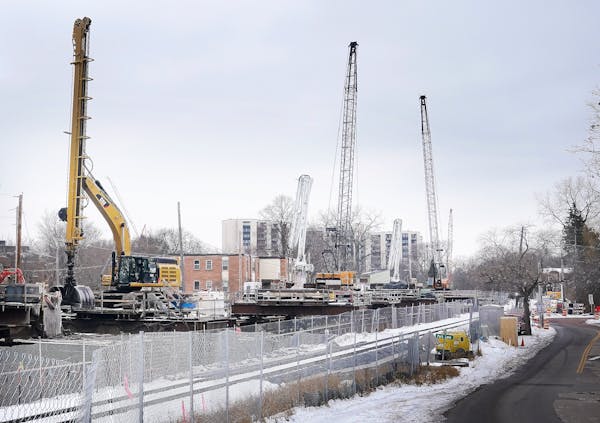Construction of a tunnel in Minneapolis for the Southwest light-rail line has revealed an "impediment" that could add even more expense and delay to the $2.7 billion project.
Contractors working in the Kenilworth Corridor recently encountered what appears to be a large piece of concrete about 3 feet away from the foundation of the Cedar Isles Condominiums, which were built in the 1980s from repurposed grain silos.
This pinch point in the narrow corridor between Lake of the Isles and Cedar Lake has long been a source of contention between condo residents and the Metropolitan Council, which is building the 14.5-mile extension of the Green Line.
Already the most expensive public works project in state history, Southwest is more than $1 billion over budget and delayed nearly a decade, partly because of the difficulties associated with building the half-mile long tunnel.
"We did encounter an impediment that we're trying to investigate," said Southwest's project director, Jim Alexander, at an advisory committee meeting earlier this month. "We're not quite clear what it is yet. This could be another delay that we have to experience."
The Southwest line, which is more than 70% complete, is supposed to begin passenger service between downtown Minneapolis and Eden Prairie in 2027.
Project spokesman Trevor Roy said the blockage is not a boulder or a rock and that it appears to be concrete. "Once we know more specifically what we are dealing with, we will have more accurate information as it relates to potential delays and costs," he said.
The news has been "stressful and frustrating" for residents of the condominiums, who have long warned the Met Council that construction taking place within feet of their homes could be problematic, said Vanne Owens Hayes, president of the Cedar Isles Condominium Association.
Cracks have already surfaced in ceilings and floors, and the condos' underground parking garage flooded last year after a water main break during light-rail construction. That's on top of the usual noise and inconvenience associated with a large construction project.
"It's not only frustrating living through it, we're also paying for it as taxpayers," Owens Hayes said.
Condo residents and the Met Council are now engaged in mediation to resolve outstanding issues — a process led by Kathleen Blatz, former chief justice of the Minnesota Supreme Court. Both sides have declined comment on the negotiations.
The latest news has condo residents worried that excavation to investigate the impediment could destabilize their building. Some have speculated that the concrete could be something that was discarded and buried when the grain silos were built in 1915 and 1928, perhaps part of the foundation or a tunnel that extends under the building.
Roy said the impediment wasn't discovered before construction began because soil testing didn't go that deep.
After soils shifted during tunnel construction in 2021, the council approved a different construction method using a 500-foot secant wall where the tunnel runs within feet of the condos. Secant walls are formed with intersecting concrete piles to provide excavation support.
Tunnel construction in the Kenilworth corridor continues. But work on the project's secant wall, which is more than 90% complete, was paused last week because of the impediment.
"It will be tougher in winter to investigate," Alexander said. "Everything slows down in this kind of weather. It does compromise the efficiency of things."
The state Office of the Legislative Auditor is expected to release the first of two reports probing the Southwest line's delays and cost overruns later this month. The project's budget is still about $260 million short.
"The whole episode is just so emblematic of the entire project, where engineering assurances have proven to be worthless, and potential problems dismissed or discounted, leading to enormous delays and cost hikes," said Russ Palma, vice president of the Cedar Isles condo association.
"You have no idea how maddening it is to hear this steady drip, drip of issues as a resident of our building, with the attendant never-ending delays," he said.

Former diversity worker sues University of Minnesota after firing over swastika photo

As longtime Hutchinson, Litchfield papers close, 2 newspapers launch to take their place

In Grand Rapids, Itasca Pride is planning its first event, but there is already pushback
Mother charged with fentanyl overdose death of her 8-month-old boy in Roseville hotel room

